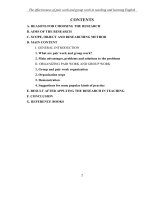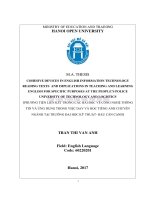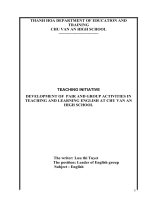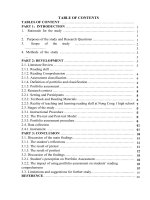using facebook as a tool in teaching and reviewing english idiomatic expressions for grade 12th students
Bạn đang xem bản rút gọn của tài liệu. Xem và tải ngay bản đầy đủ của tài liệu tại đây (7.18 MB, 67 trang )
NGHE AN DEPARTMENT OF EDUCATION AND TRAINING
NAM DAN I HIGH SCHOOL
TEACHING EXPERIENCE
USING FACEBOOK AS A TOOL IN
TEACHING AND REVIEWING ENGLISH
IDIOMATIC EXPRESSIONS FOR GRADE
12TH STUDENTS
SUBJECT: ENGLISH
AUTHOR: VÕ THỊ DOAN
GROUP: ENGLISH 12
Nghệ An, 2021
NGHỆ AN, 2020
1
TABLE OF CONTENTS
2
PART 1: INTRODUCTION
1.1. Rationale
1.1.1. The necessity of acquiring English idiomatic expressions to language
learners
Idioms are a significant part of acquiring a language and often indicate
proficient learners. English idioms are a part of the cultural elements of the
language which should be mastered by EFL learners. By developing a clear
understanding of figurative language, such as idiomatic expressions, students
can further comprehend texts that contain metaphorical and lexical meanings
beyond the basic word level.
Idiomatic expressions or idioms should not be neglected and should not be
taken for granted. Idioms are used daily and repeatedly by native speakers of
English Language. Idiomatic expressions are a part of every language's
vocabulary and are based on that language history, heritage, and culture.
Learning idiomatic expressions helps non-native speakers of a language become
more fluent, and sound more native-like. Learning idiomatic expressions
increases the vocabulary and lexicon of the English Language learners.
Moreover, idiomatic knowledge leads to a better understanding of the culture
and customs of that particular language. English language teachers should teach
idiomatic language to their students and not overlook such a vital issue because
becoming more native-like in English Language is by learning idiomatic
expressions, understanding their meaning and using them frequently.
To grade 12th students, idioms learning is especially important because
they appear in the entrance test papers. Some idioms exist in reading passages
that may prevent them from reading comprehension. Some idioms appear in
some separate questions. Therefore, to get high scores in the entrance tests to
universities, students have to have a good knowledge of idioms. These are the
examples of the questions relating to idioms in the entrance paper tests:
Question 12 (year 2020, code 404) : Mark the letter A, B, C or D on the answer
sheet to indicate the words OPPOSITE in meaning to the underlined words.
3
Everyone was secretly rehearsing a surprise performance for Alex’s proposal,
but annoyingly Jim let the cat out of the bag at the last minute.
A. abandoned a plan B. concealed a plan C. revised a plan D. disclosed a plan
Question 8 (year 2017, code 401): Mark the letter A, B, C or D on the answer
sheet to indicate the words CLOSEST in meaning to the underlined words.
It's not a pleasant feeling to discover you've been taken for a ride by a close
friend.
A. driven away
B. deceived deliberately
C. given a lift
D. treated with sincerity
This is an example of the idioms that appears in the reading texts:
●
Cut from a reading passage in the paper test for the GCSE exam, school year
(2019-2020), code 404:
…..Alternatively, they may decide to take a gap year between graduating from
university and starting a career feeling the need for some time out before joining
the rat race. …….
From above reasons we can see that it is essential to teach English idioms
to our students. Therefore, they can better their communication, their reading
comprehension and their exam scores.
1.1.2. Students’ difficulties in learning idioms at high schools
Most of the students at high school find it challenging to use idioms in
communication and to deal with the questions relating to idioms. The author has
conducted some pieces of interview to have a close look to the difficulties that
teachers and students have to face when teaching and learning idioms. At the
beginning of the school year, she also delivered a test to check students’
knowledge of English idioms (see appendix I). The results of the test have
shown that most of the students have poor knowledge of English idiomatic
expressions. Following are some difficulties that students have met when they
learn English idioms.
First of all, one of the main blocks of L2 idiom learning is that idioms are
often unpredictable in meaning, that is, their meanings cannot always be derived
4
from the literal meanings of the constituent parts. Therefore, most students agree
that they really have to learn them to know their exact meaning and avoid
misunderstanding them.
Secondly, it is the fact that there are a lot of idiomatic expressions in
English but only few idioms appear in the text book so most students do not
have chances to acquire them. Students mostly learn idioms in extra classes and
from reference books. It is undeniable that idioms are not treated in classrooms
as regularly as might be because of time pressure. In fact, teacher must spend
time on other tasks appearing in textbooks. However, many students say that
they need a reliable source of idioms from teacher to learn rather than find the
idioms themselves.
Last but not least, it is very difficult to remember the idioms because
students do not have chance to use them frequently in daily communication or
they are not frequently exposed to them. In fact, to master and use the idioms in
communication, they must have chances to practice them and have chances to
do the tests on them. Some teachers overwhelm students with idioms by giving
them a list with a lot of idioms and ask them to remember. It is useless because
students can not remember all of them at one time. It is advisable that idioms
should be introduced a few at one time. It is important for teachers to design
various activities for students to use English idioms and subsequently acquire
them efficiently. It is necessary that idioms should be introduced separately at
different time and with interesting contexts. Moreover, students must have
chances to practise using them and doing some kinds of tests about them.
1.1.3. Benefits of teaching and reviewing idioms via Facebook.
As a teacher of English at high school, the author would like to find ways
to help students overcome above difficulties and provide students with as many
opportunities to master English idiomatic expressions as possible.
During the time of teaching English at class 12D2, the author has seen
that thanks to the development of economy and technology, all students in this
class have their own smart phones and all of them use Facebook daily.
Facebook has become one part of their lives and they use it frequently to get in
5
touch with others.
Since they use Facebook frequently and comfortably,
teachers may exploit this entertainment-oriented site as an edutainment tool.
Although there are many tools available for eLearning, Facebook seems to be
one of the most effective tools because students generally respond to discussions
quickly and are comfortable enough in their "space" to share their information
and opinions. By using Facebook in learning, the role of students can therefore
shift from only receiving knowledge to both searching and sharing their
knowledge. Moreover, interactions with teachers can become more instant since
teachers and students can respond quickly via Facebook. Facebook is so a
miraculous learning tool, “Why doesn’t the teacher make full use of the social
network to help students acquire idiomatic expressions frequently?” This
question has led the author to the thought of using Facebook to teach and review
English idioms for students.
By using the class’s Facebook page for teaching English, teacher can
introduce the idioms frequently at any time of the day, not necessary at the class
time. With interesting drawings and funny examples, teacher can make it easier
for students to remember the idioms. Especially, teacher usually posts the idioms
on some popular topics like food, weather, body parts, money, and emotions so
the most of the idioms are in a close relationship, which makes students
remember the idioms more easily. It is the class rule that after the teacher has
posted the idiom, the students have to comment the examples they make for that
posted idiom. As a good result, students have many chances to read many
interesting examples from their friends and they are able to have deep
understanding into that idiom. One more benefit is that the students’ examples
are often corrected by the teacher if they are incorrect.
Especially, introducing idioms via Facebook can help students save time.
They can learn and review idioms at any time when they have their smart
phones in their hands. They can respond to the teacher posts during the break
time at school or before going to bed or when they are going out with their
friends. It is a good chance for them to make full use of their Facebook surfing
time.
6
One more special benefit which the teacher has realized is that all the
students in class D2, even some lazy students who do not have intention to learn
idioms, have been engaged in learning idiomatic expressions because of the
rules of interaction given by the teacher at the beginning of the school year.
Most of the students have the feeling of comfort to interact on Facebook. The
involvement of all students in class D2 in learning English idioms satisfies the
teacher a lot. It is clear that when they try to think of the examples to comment
under the post, they automatically memorize the idioms. Most of the students are
usually inspired by the funny contexts illustrated through funny drawings.
For all the things mentioned above, it is undeniable that Facebook is an
interesting and useful tool for teaching idioms to the ESL learners. In a modern
society with the development of technology, it is good to engage the students to
use their mobile phones in learning English so that they can have more chances
to learn by themselves in less stressful situations and then receive useful
feedback from their teacher and their friends. Surely, learning idioms via
Facebook also enhances student’s learning autonomy and helps them to become
active learners.
However, the teacher realizes that only posting and interacting with the
new idioms via Facebook is not enough for students to remember and use them
in daily life and deal with the questions relating to idioms. The teacher believes
that the students can learn idioms better when they are provided with
collaborative activities and they can interact with their peers and share fun in
learning. Therefore, the teacher has designed some kinds of tests and activities
after every 15 posted idioms. The tests and the activities are really helpful in
reviewing what the students have learnt so that they can reinforce their memory
of the new idioms.
1.2. Aim of the research
To help grade 12th students acquire some popular English idioms.
1.3. Objectives
In order to achieve the above aim, the writer will:
7
(1)
- Investigate to identify the current state and the problems that many teachers
and students are facing when teaching and learning idioms at the author’s
high school.
(2)
– Introduce idioms via Facebook and assign some tests on idioms for
students to practise.
(3)
- Analyze the effects of the designed activities on students’ ability to acquire
idioms.
1.4. Scope of the research
Beside the introduction and the conclusion, this research consists of three
parts:
-
Theoretical and practical background
-
Introducing and reviewing idioms via Facebook
-
Results and evaluation
PART 2: THEORETICAL AND PRACTICAL BACKGROUND
2.1. What is an idiomatic expression?
The word 'idiom' is a Greek term meaning ‘own’ or ‘peculiar’. An idiom
is a figurative expression that can usually be interpreted literally but that takes a
nonliteral meaning when used in a specific context (Rohani & Ketabi, 2012).
Idioms are pervasive in the English language. They are used in formal style and
in slang. Idioms may appear in poetry, literature, in Shakespeare language and,
even, in Bible. Idiom is “a number of words which, taken together, mean
something different from the individual words of the idiom when they stand
alone” (McMordiew, 1983: 4). An idiomatic expression “let the cat out of the
bag”, for instance, is composed of several words (let/the/cat/out/of/the/bag)
whose individual meanings do not seem to contribute to the meaning of the
idiom as a whole, which is “reveal a secret”.
2.2. Characteristics of idiomatic expressions
a. Metaphorical Meaning
8
Idiomatic expressions are, in a very broad sense, metaphorical rather than
literal. Because an idiom is metaphorical, its meaning is not predictable from the
usual meanings of the separate words from which it is formed. This can be seen
in, for example, to be on top of the world (=to be extremely happy) and to be
hard up (=to lack money):
- We were very hard up when I lost my job.
- After winning the batting title, Carol appeared to be on top of the world
Similarly, idioms such as Actions speak louder than words or The apple
doesn’t fall far from the tree are very particular to the English language and do
not make sense when you try to understand them verbatim. In these two
idiomatic expressions, actions are not really ‘speaking,’ and there is no apple or
tree. Literally translating the sentences will not help you understand them any
better; you simply must memorize what these idioms mean as a whole, so you
do not feel lost when someone says one to you.
Another common idiom used frequently is Don’t cry over spilt milk. Again,
this expression has absolutely nothing to do with milk. Instead, the milk is a
metaphor for a past event that you are worrying about right now. This expression
implies that ‘what happens in the past stays in the past,’ so you shouldn’t be
upset or ‘cry' about something bad that happened yesterday (spilt milk) that you
cannot do anything about now.
b. Invariability
Idioms are more or less invariable, both in wording and in certain
grammatical ways. They cannot, therefore, be changed or varied in the way
literal expressions are normally varied, whether in speech or writing. Some
idioms cannot be changed at all. For example, the idiomatic sentence *The
University praised the students who had worked to help those who were outand-down in London is ill-formed, whereas The University praised the students
who had worked to help those who were down-and-out in London is perfectly
acceptable. In brief, most idioms resist variation in form, and tend to be
relatively fixed with regard to the following:
9
●
Replacement
A speaker or writer cannot normally replace a word with another in the idiom
phrase. We cannot say *on top of the universe/globe, but we can say on top of
the world (=to be very happy). Spill the peas is not an idiomatic expression but
spill the beans (=to give away secret information) is idiomatic.
●
Word Order
We cannot change the order of words in an idiomatic expression, e.g. It was
raining cats and dogs (=It was raining very hard), but not *It was raining dogs
and cats. The idiom phrase be left high and dry (but not *be left dry and high)
means to be left without any help or without the things you need.
●
Number
Almost all idiomatic expressions do not in one way or another admit of the
usual grammatical operations which literal phrases will permit. For example, we
cannot turn the object of the idiomatic expressions give up the ghost and kick
the bucket into the plural without losing the idiomatic meaning. Thus, one
would not say *The men gave up the ghosts/*The men kicked the buckets.
However, a singular noun may be replaced by a plural noun in a literal sentence,
e.g. The men kicked the (milk) buckets/pails. One cannot turn cats and dogs in It
was raining cats and dogs into the singular, either: *It was raining a cat and a
dog).
● The Use of Actives/Passives
Normally a transitive verb phrase can be changed to a passive: The man
kicked the pail/The pail was kicked by the man. When one uses an idiom,
however, some grammatical operations, like the formation of the passive, are
impossible. For example, one may use the idiom kick the bucket in a sentence
like At 3 o'clock John kicked the bucket. We cannot change the grammatical
structure of this sentence, i.e. we cannot re-write the sentence in the passive. It
would sound quite unnatural to say At 3 o'clock the bucket was kicked by John.
2.3. The importance of idioms
10
An idiom is a phrase or saying that is commonly used in everyday English
and in written to express certain ideas or opinions. Understanding English
idioms is important because they require a deeper familiarity of the English
language to comprehend what someone means when they use them in
conversation and in their writing.
Idioms may seem complicated at first, but they can actually be a lot of fun to
learn. Following are the reasons to explain why idioms are so important to the
students’ English language learning.
First of all, idioms give the students a new way to express themselves in
English Language. The meaning of an idiom generally depends on the specific
context in which it is used. When someone in America tell another one to ‘break
a leg’, for example, they aren’t saying that in a literal sense, but instead are
wishing her/him good luck, usually before a performance. Clearly, idioms are
particularly useful because they provide students with a new, creative way to
express themselves. Rather than saying ‘you should study hard”, they could say
‘You should hit the books”, which is a more complex and interesting expression.
Idioms can also be quite humorous to use, which allows students to express
themselves in a more genuine way, including showing off their personality and
sense of humor.
Secondly, understanding idioms can boost our students’ conversational
English skills. They may encounter idioms most often in spoken or written
conversation. Idioms can help improve their conversational skills because it
shows native speakers that they understand the cultural meaning and context
behind the idioms they are using. This can help them feel more comfortable and
confident with their conversational abilities.
Finally, learning about idioms can help enrich the students’ language and
help them be more native-like. Native speakers often use idioms more than
someone who is new to the language, simply because they are more familiar
with them and know the context in which they should be used. Therefore, when
the students use an idiom, they sound more like a native speaker. If we think of
English as if it were a soup – the basics may be good, but we need a little extra
11
flavor to take it to the next level. Idioms, in that sense, are the spices that the
teacher can add to his/her students’ English skills. Understanding the basics of
English is a good start, but idioms can help the students explore the language in
a deeper, more meaningful way.
2.4. Overview the previous studies on the subject of idioms and the
contribution of the teaching experience
Idioms are a difficult part and very important for most ESL learners to
learn so up to now, there have been some of the studies on the subject of idioms.
The first one is “A Study of the Problems of Learning and Translating
Idioms” by Asst. Prof. Dr. Abdul Majeed Hameed Joodi in the College of
Education for Women at University of Baghdad. In this study, the author has
mentioned many problems that the students encounter when they learn and
translate English idioms. He also mentions a lot of solutions to solve those
problems.
The second one is “Investigating the Difficulties Faced in Understanding
English Idioms” by Winis, Noora & Zakaria, M. In this study, the author has
investigated many difficulties in understanding English idioms like students’
lack of cultural knowledge, students’ poor vocabulary knowledge, the
unpredictable meaning of the idioms.
The third one is “Strategies and Difficulties of Understanding English
Idioms: A Case Study o of Saudi University EFL Students” by Maha H.
Alhaysony, published by Canadian Center of Science and Education. This study
stresses that because the students are lack of the cultural knowledge of the
English language so they can not have a good knowledge of idioms and it
mentions the strategies that may help students improve the cultural knowledge
and then have a deep understanding about English idioms.
To the best of the author’s knowledge, so far there have been no studies
investing the effects of using Facebook as an useful tool to teach and review
English idioms. The author believes that this is a good way to make full use of
the social net work and increase the students’ interaction and the participation in
12
learning English idioms. The author is also sure that the students really have fun
time to share and to learn with each other on Facebook.
PART 3: INTRODUCING AND REVIEWING IDIOMS VIA FACEBOOK
3.1. Participants
The participants are 45 students in class 12D2 (school year 2019-2020).
Following is the participants’ demographic information.
Participants’ demographic information
Number of participants
45
Age
17-18 years old
13
Gender
Female/37
Male/ 8
Accumulated English learning experience
10 years
English oral proficiency level
A2 and B1 (CEFR)
Most of the students in Class 12 D2 are quite good at English and they
spend a lot of time studying English with the aim of being able to communicate
in English and get high English scores in the entrance examination to
universities. However, most of them find it really hard to use English idioms in
communication and deal with the exercises relating to idiomatic expressions.
They say that in grade 10 and 11, their former teacher of English did not teach
them any English idioms so now they really want to have some extra exercises
to improve their knowledge of English idioms. When the teacher suggests using
Facebook to interact and learn about English idioms, all of them are excited and
ready to do the given tasks.
3.2. Procedures to introduce and review idioms
Step 1: Teacher provides students with a training session at the beginning
of the school year.
-
At the beginning of a new school year, teacher asks one student in the class to
create a private Facebook Page for learning English and asks him to add the
nicks of all members in the class to the page.
-
The teacher provides students with a training session in which she explains and
demonstrates the ways and the rules to learn English idioms via Facebook and
the students raise the questions about the things they are not clear about.
Step 2: Teacher posts idioms with interesting contexts and on popular
topics one by one on class Facebook page (about 4-5 idioms per week). Students
have to actively interact with the teacher’s posts by commenting examples and
correcting their friends’ mistakes. The teacher also corrects the mistakes for the
students if necessary. Look at appendix D to see how effective the students and
the teacher interact with each other.
14
Step 3: After every 15 posted idioms,
-
Teacher asks students to make the simple conversations on some certain
idioms (group work)
-
Teacher delivers the tests or an activity to help student review what they have
learnt. The tests may be in form of a game, a paper test or an online test.
-
Besides, the teacher also asks six groups in the class to choose from 15
posted idioms their favorite idiom and together draw the picture to illustrate
it.
3.2.1. Idioms with interesting contexts
On the class facebook page, the teacher posts the idioms with iteresting
contexts. The idoms are usually illustrated by funny drawings and examples that
can inspire the students and help them memorize the idioms more easily.
In the school year of 2019-2020, the teacher was able to introduce 130
idioms for students to learn via the class facebook page. The students did 10
tests and each group had 9 drawings to review the idioms they had learnt.
Normally, teacher introduces the idioms on some of popular topics, which
helps students remember the idioms better.
Topic 1: idioms relating to emotions
Topic 2: idioms relating to animals
Topic 3: idioms relating to body parts and clothes
Topic 4: idioms rel ating to money and cost
Topic 5: idioms relating to water and food
Topic 6: idioms relating to time
Topic 7: idioms relating to health
Topic 8: idioms relating to colours
….
15
Below are some examples of the 130 idioms that the teacher has
introduced to the students on the class facebook page:
●
Idioms relating to emotions
16
17
●
Idioms relating to animals
18
19
●
Idioms relating to water, fruit and food
20
●
Idioms relating to body parts and clothes
21
22
23
●
Idioms relating to money
24
●
Other idioms
25









